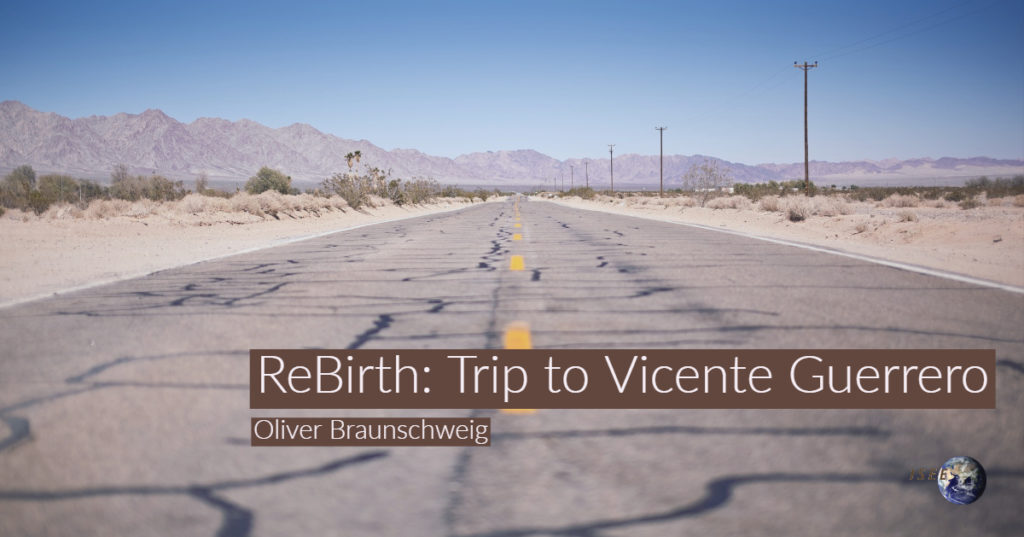
Prior to ISEE2018 Conference in Puebla, Mexico, a visit to Vicente Guerrero peasant community was arranged. Here is a report from a participant.
Rebirth: Trip to Vicente Guerrero
by Oliver Braunschweig*
Rebirth, I would say, is the theme of the three days we spent with the community of Vicente Guerrero.
Vicente Guerrero is a small indigenous peasant community in the state of Tlaxcala in Mexico, among the poorest areas in Mexico. But the wealth of this community, into which we were invited with such open arms, is difficult to measure in money. For three days we ate their excellent, self-grown food, and we got an illuminating and touching peek into their agro-ecological and cultural traditions.
The past 40 years of this community are indeed telling a story of rebirth. All these years ago, the typical family—then numbering 10 to 12 heads—could only feed itself off of its own land during half the year, producing about 600 kg of maize and 200g of beans (frijoles) per hectare. Because they had heard about what a Guatemalan community had achieved, they sent a delegation there to learn their agroecological practices. The delegation brought these ideas back, but their fellow campesinos and campesinas did not believe them. So, they started to apply it, and to adapt these and many more ideas over the years. By now, about 90% of the community (with 80% of the land) has adopted these practices which include composting, as well as terracing the land and dredging ditches to retain rain water (700 mm per year, but only during few months, and often in heavy rains) and to reduce soil erosion. Though the municipality they are part of is now called Españita, the original name of the place was Axaxacuala which means “place of dams”. Slowly, they seem to return to the reality which had given it this name.
The total area of Vicente Guerrero is 700 hectares, of which 200 are communally held but individually farmed, and 100 hectares are held for the recovery of flora and fauna. The rest is privately owned by the 112 families which own land (out of 290 families in total). The community also bought the area where they get most of their water from to safeguard it for the village. While family size has fallen by about half over the past decades and total population has increased (partly through people moving into the community), they have also been able to build up an additional 30 cm or more of topsoil. Per hectare, they now produce between 3-5 tons of maize as well as beans, several types of squash, medicinal herbs, amaranth, and more. To secure the earth mounds and water ditches of the terraces, they plant agave (a cactus). By now, the families in Vicente Guerrero do not only feed themselves all year from their own lands, they can even sell surplus produce in a local market in the nearby town of Tlaxcala. This market, which they started together with other campesinas and campesinos of the area, is also where we started our visit to get a flavor of the local society. So, let me start at the beginning of our trip.
Tlaxcala
We, a group of activists and researchers met up on Friday morning, 7 September, at the Mexico City airport; the trip was organized as a study tour, prior to the XV Congress of the ISEE. In a small bus we were driven to the town of Tlaxcala, where we visited the already mentioned agroecological market. It is a small market, with less than a dozen stands, selling pottery, spices, vegetables, bread, honey and sweets, but also several freshly prepared dishes to be consumed right there: small fried fish, freshly pressed and pan-fried tortilla, and some other local specialties including insects, common in rural Mexican diets. The Spanish-speakers among us translated everything diligently and continued to do so during the rest of the trip. A big thank you to both Ana and Balam for this! We had pleasant, interesting conversations with the shop-keepers, and those of us who spoke less Spanish made use of our ability to move our hands, to point at things, and to laugh.
City Hall Mural Paintings
Later, visiting the mural paintings in the city hall, we learned about the ancient state of Tlaxcala, as well as the history of how they first defeated the Spanish Conquistadores, only to enlist them in their fight against their arch-enemy, the Aztecs. The evening was spent with some down-time, walking around in the village of Vicente Guerrero, and eating dinner—a simple and delicious, traditional meal with tortillas, frijoles (beans), salsa, and more. We had variations of these basically at each meal, delicious.
Practices
As we were to learn on the third day, they had structured our visit differently from how Academia normally progresses (or how this article is written). In Academia, we often first go into theory, and then possibly into practice. Instead, they first showed us their practices: we stayed in a local home, we ate their food and we saw their lands. We learned to physically experience the work and sense of their practices. After a hearty breakfast we heard music blasting through the community loudspeakers: I imagine it is a great way to start the workday together. And so we split into two groups and went into the fields with Emiliano and Pablo to learn how they do terracing with our own hands. It was fun and very informative. Pablo, the guide in my group, noticed something peculiar on the other side of the valley from where we were: He told us about this spot, which had been reforested to stop soil erosion, but where the fledgling forest had recently burned. Now there were sheep grazing in this area. He assumed that the farmer had burned the area on purpose, and so went over there with one of us (who was going to pretend to be a government agent) while we dug small ditches to learn about the principles at play in water storage and the preventing soil erosion on their land.
They were successful (the shepherd quickly took off), and we continued with our “practicas”. In one of them we compared alive and dead soil: if you pour hydrogen peroxide on soil and it bubbles, it has organic material. Petrochemical agriculture tends to harm the important organic material in the soil, while their agroecological techniques build them up and make the soil more resistant, for example also to drought. But we did not only learn from the community alone: In our group, we had a wonderful variety of backgrounds, knowledges, and topics of concern. Some of us were indigenous of the place of provenance, other offspring of colonial ancestors; from the Maasai in Kenya, from the First Nations in Canada, from Mexico and Ecuador, and from European ethnicities too—scholars and activists alike. Some with deep connections to their lands and traditions, reclaiming their inheritance—others trying to build new communities—all of us with a joint interest in building communities and knowledges for the anthropocene. Among the many conversations we had, there was a remarkable similarity of the experiences of indigenous populations in the face of capitalist agricultural and mining projects, stories of land grabbing, oppression and denial of their human rights. And yet, we also heard stories of successes, of legal wins, of inspiring learning, and of the transmission of oral traditions which had sustained their peoples in their specific ecologies for so many generations. Hurt and desperation were mixed with hopeful messages of wins and successes. We might even say stories of death and rebirth.
Temazcal
It is only fitting that we participated in a Temazcal (a traditional steam bath) ceremony, symbolising rebirth out of the womb of mother earth. It started by us invoking the four cardinal directions, four colours, and the four elements (rain, earth, wind, and fire), as well as what they grant to us as humans. Each one of us holding a candle, we thanked and greeted the earth with our voices, drums, and by blowing on a sea shell. After a traditional cleaning ritual with smoke being blown onto us, we each slowly crawled backwards into the pitch-dark Temazcal: As it is the opposite of birth, you move in with the head last. It had been heated up with hot stones, and the local campesino who initiated and led the ceremony splashed herb water onto them to create steam. Because of the heavy rains a little earlier, the Temazcal was colder than it should have been, but the heat slowly increased until it was very nice and hot. It was a moving, deeply reverberating experience for all of us; the singing of traditional songs (probably the first time First Nation songs and Jewish songs had been sung in there), the story-telling of hurt and hope, drinking the traditional herbal tea, cleaning ourselves with medicinal herb water, rubbing the skin with fresh aloe, and using yet another herb to open the pores of our skin. All of this in absolute steamy heat and darkness. Coming out of the Temazcal, out of the womb of mother earth, we wished everyone who left a “happy birth”. A ceremony combining earth, water, and heat, it evokes agriculture, and the ability of nature to recreate itself each year with the help of soil, rain, and warmth, and it is about us humans cleaning ourselves, shedding the hurtful and reclaiming vigor and hope; two kinds of rebirth.
Discussing Experiences
The last day saw us talking about our experiences, learning the history of Vicente Guerrero, the struggles and wins (including a recent law banning GMOs and making the local grains the common property of all campesinos and peasant communities), and how they had come to be where they are now. A community which, over the past twenty years, has developed strong relations with researchers at nearby universities, where the researchers and the community members converse as equals, and where the research is guided by and centered on community needs. A community in which the young, after their studies in the cities, do return to their lands again and contribute to the common development: The rebirth of a community. Witnessing the pride and health of this community, the outcome of decades of continuous and continuing work, we all left inspired. The XV Conference of the International Society for Ecological Economics was about to start. An unforgettable start for this conference, and experiences which will impact all of us, I am sure, for a long time.
May these stories of rebirth be a blessing for these communities and for us, and may they serve as guiding memories in our tasks as Ecological Economists.
——————————————————–
*Oliver Braunschweig is a 4th-year PhD student in Economics at the New School in New York. He focuses on Ecological Economics, (Economic) History, and questions of Value and Money. The responsibility for the accuracy of this article is his responsibility, though he would like to thank everyone who helped with inputs for this article.


3 Responses
Dear Oliver,
Thank you very much. I really wanted to get to Vicente Guerrero and it turned out I could not. So your report helps me accept this loss. I could have felt it more deeply if I had joined.
The community really seems to have overcome its trials of the past.
Best
Dear Joe
Thank you very much for your comment. It was a deeply moving experience, and I’m glad that my article seems to have brought this out also for you as a reader.
Best
Oliver